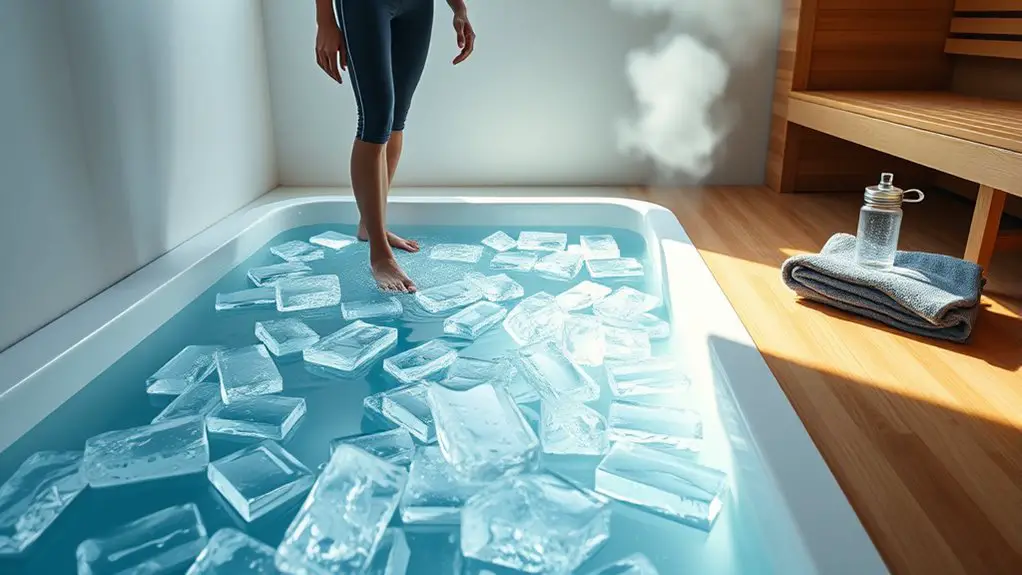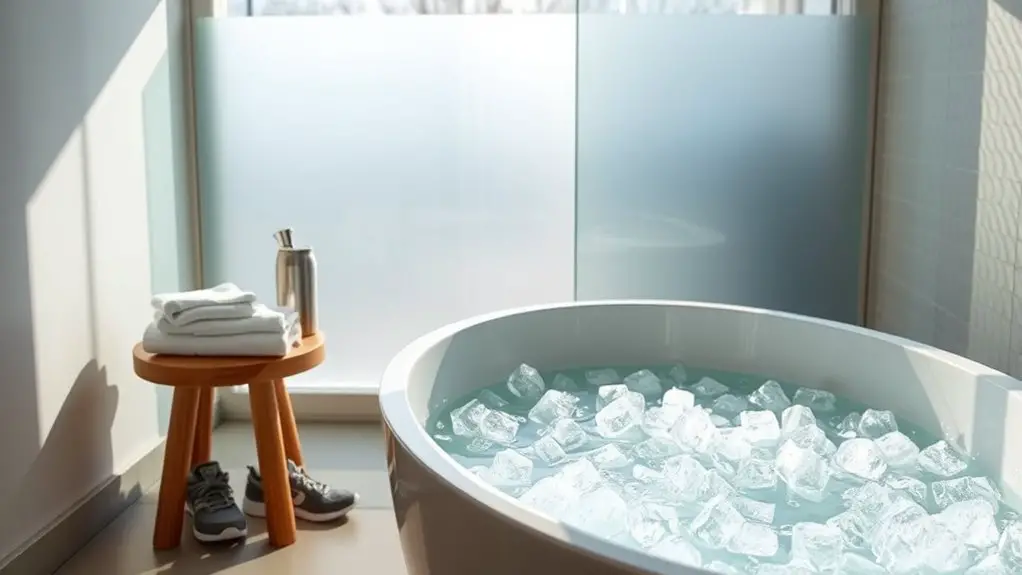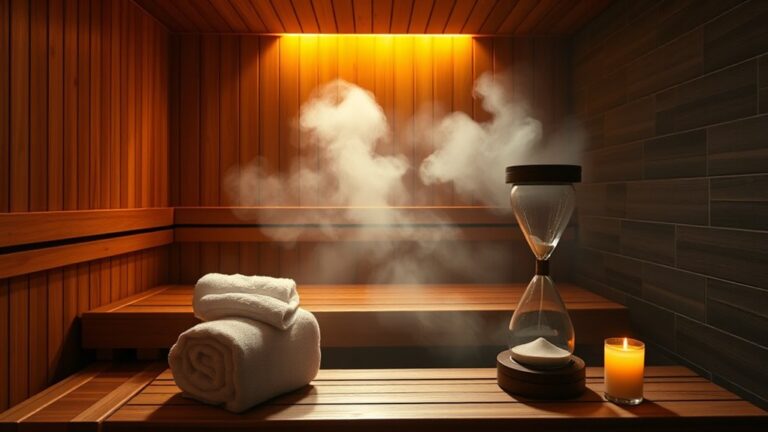How to Use Ice Baths for Post-Workout Recovery

To use ice baths for post-workout recovery, immerse yourself in water between 50°F and 59°F for 10-15 minutes, ideally within two hours after exercising. This helps reduce muscle soreness and inflammation while promoting faster healing. Prepare mentally with deep breathing and a warm shower to ease into the cold. Make sure to replenish electrolytes and monitor your body’s response for peak recovery. There’s more to learn about enhancing your recovery routine effectively.
Understanding the Benefits of Ice Baths

When you push your body to its limits during workouts, understanding the benefits of ice baths can be vital for optimizing recovery. A benefits overview reveals that ice baths markedly reduce muscle soreness and inflammation, which can be essential for maintaining your performance levels. Research indicates that exposure to cold water helps constrict blood vessels, limiting swelling and flushing out metabolic waste products.
The health impact extends beyond immediate recovery; regular use of ice baths may also enhance your overall athletic endurance by promoting faster recovery times. This means you can train harder and more frequently without the drawbacks of prolonged soreness. Additionally, ice baths may improve your mental resilience, teaching you to cope with discomfort, which can translate to better performance under pressure. By incorporating ice baths into your routine, you’re not just recovering; you’re actively improving your training outcomes and protecting your long-term health.
The Science Behind Cold Water Therapy
While many athletes swear by ice baths for recovery, the science behind cold water therapy reveals a complex interplay of physiological responses. When you submerge in cold water, your body experiences a cold shock, triggering various mechanisms. This response promotes inflammation reduction, which is essential for muscle recovery after intense workouts. The cold stimulates nerve function, enhancing pain relief and aiding in tissue repair.
Moreover, cold exposure has notable metabolic effects, such as boosting your metabolic rate and encouraging hormonal balance, which can be beneficial for overall recovery. Additionally, it fosters mental resilience by challenging your tolerance to discomfort. This combination of physiological changes not only accelerates recovery but also primes your body for subsequent physical challenges. Understanding these mechanisms can help you harness the full potential of ice baths, making them an effective part of your post-workout routine.
When to Take an Ice Bath

Timing your ice bath is essential for maximizing recovery benefits. Ideally, you should aim to take an ice bath within 30 minutes post-exercise, and the duration should typically range from 10 to 15 minutes. Additionally, it’s important to reflect on your individual recovery preferences, as personal comfort levels can influence the effectiveness of the treatment.
Optimal Timing Post-Exercise
To maximize the benefits of an ice bath, it’s essential to evaluate the ideal timing for immersion after exercise. Post workout timing is critical for recovery optimization. Ideally, you should aim to take an ice bath within 30 minutes to two hours after your workout. This window allows your body to reduce inflammation and muscle soreness effectively. Consider the following:
- Immediate immersion (within 30 minutes) can help jumpstart recovery.
- 1-2 hours post-exercise is effective for restoring normal muscle function.
- Delayed immersion (beyond two hours) may still provide benefits, but the effectiveness could diminish.
Duration of Ice Bath
The ideal duration for an ice bath typically ranges from 10 to 20 minutes, depending on your individual tolerance and specific recovery needs. Shorter sessions can still provide effective ice bath benefits, such as reduced muscle soreness and inflammation. Research suggests that immersing yourself in cold water for this time frame can activate recovery techniques that enhance blood flow and promote healing. However, going beyond 20 minutes may lead to diminishing returns or even adverse effects like hypothermia. It’s important to listen to your body; if you start feeling excessively cold or uncomfortable, it’s best to exit sooner. By following these guidelines, you can maximize the effectiveness of your ice bath routine while ensuring a safe and beneficial recovery process.
Individual Recovery Preferences
While individual recovery preferences can vary greatly, knowing when to take an ice bath can greatly enhance your post-workout recovery. Timing is essential, as ice baths can be more beneficial depending on your workout intensity and personal preferences. Consider these factors when deciding:
- Type of Workout: If you engaged in high-intensity or prolonged exercise, an ice bath might be more beneficial.
- Muscle Soreness: If you’re experiencing significant soreness, taking an ice bath soon after your workout can help reduce inflammation.
- Recovery Methods: Ice baths can complement other recovery techniques, so assess how they fit into your overall regimen.
Ultimately, listen to your body and experiment with timing to discover what works best for your recovery journey.
How to Prepare for Your Ice Bath

Preparing for an ice bath requires careful consideration to maximize its recovery benefits. Start with pre-bath preparation by ensuring you have everything you need, such as ice, a thermometer, and towels. It’s essential to set the water to a temperature between 50°F and 59°F (10°C to 15°C) for ideal results.
Next, focus on your mental readiness. Ice baths can be a shock to your system, so mentally preparing yourself can enhance your experience. Take a few moments to breathe deeply and visualize the benefits you’ll gain, such as reduced soreness and quicker recovery times.
Consider taking a warm shower beforehand to ease the shift into the cold water, and always listen to your body. By addressing both physical and psychological aspects of your ice bath preparation, you’ll set yourself up for a successful recovery session.
Step-by-Step Guide to Taking an Ice Bath
Taking an ice bath can be a highly effective way to enhance your post-workout recovery. To maximize the benefits, follow these step-by-step ice bath techniques:
- Prepare your space: Fill a bathtub with cold water and add ice. Ascertain you have a towel and warm clothes nearby for after the bath.
- Ease into the bath: Gradually lower yourself into the ice water, allowing your body to adjust to the cold. Focus on your breathing to maintain control.
- Stay mentally resilient: Use visualization or mindfulness techniques to stay relaxed during the process. Concentrating on your breath can help you endure the cold.
Duration and Temperature Recommendations

To achieve ideal recovery benefits from ice baths, it is crucial to evaluate both duration and temperature. Research suggests that immersing yourself in an ice bath at a temperature between 50°F and 59°F (10°C to 15°C) is most effective for reducing muscle soreness and inflammation. Aim for a duration of 10 to 15 minutes, as studies indicate this timeframe effectively balances recovery with potential risks of prolonged exposure.
Many ice bath myths suggest longer sessions lead to better results, but this isn’t supported by evidence. Instead, shorter, consistent ice baths can be a better strategy within your overall recovery plan. Remember, individual tolerance varies; listen to your body and adjust accordingly. By incorporating these temperature and duration guidelines into your recovery strategies, you’ll maximize the benefits of ice baths while minimizing the risks associated with extreme cold exposure.
Post-Ice Bath Tips for Optimal Recovery
Having completed your ice bath, the next steps in your recovery process can greatly enhance the benefits you’ve just experienced. To optimize recovery, focus on two essential components: post ice bath nutrition and hydration strategies.
Consider the following tips:
- Replenish electrolytes: After an ice bath, your body may lose essential electrolytes. Consuming a sports drink or electrolyte-rich foods can help restore balance.
- Prioritize protein intake: Fuel your muscles with protein-rich snacks or meals. This aids in muscle repair and growth, maximizing the recovery effects of your ice bath.
- Stay hydrated: Water is vital for recovery. Make sure to drink enough fluids to maintain hydration levels, aiding in muscle function and overall recovery.
Common Mistakes to Avoid

While ice baths can be an effective recovery tool, many people unknowingly make mistakes that diminish their benefits. One common misconception is that longer exposure leads to better results. In reality, staying in an ice bath for too long can cause more harm than good, leading to numbness and even frostbite. Additionally, some believe that ice baths should feel unbearable. However, the ideal temperature ranges from 50°F to 59°F, and discomfort should be moderate, not extreme.
Another mistake is skipping proper preparation. You should gradually acclimate your body to cold exposure instead of jumping in abruptly. Finally, ignoring hydration is a critical error; dehydration can worsen muscle soreness post-bath. Avoiding these ice bath myths and understanding the science behind cold therapy will guarantee you maximize recovery benefits effectively. Remember, informed practices enhance your performance and overall well-being.
Alternatives to Ice Baths
For those who find ice baths uncomfortable or ineffective, several alternatives can still aid in post-workout recovery. Here are some effective methods worth considering:
- Cold compresses: Applying cold compresses to sore muscles can reduce inflammation and pain without the shock of an ice bath.
- Contrast therapy: Alternating between hot and cold water can improve circulation and help with recovery, making it a versatile option.
- Active recovery: Engaging in light activities, like walking or gentle stretching, promotes blood flow and muscle relaxation.
Additionally, incorporating massage therapy can alleviate muscle tension, while compression garments support recovery by enhancing circulation. Don’t overlook herbal remedies and nutrition strategies; foods rich in antioxidants can aid in reducing muscle soreness. Experimenting with these methods can help you find what works best for your body.
Incorporating Ice Baths Into Your Recovery Routine

To effectively incorporate ice baths into your recovery routine, you’ll want to take into account the best timing, duration, and temperature for your sessions. Research suggests that post-workout ice baths can greatly reduce muscle soreness if applied correctly. Additionally, it’s vital to adhere to safety precautions to maximize the benefits while minimizing any risks.
Optimal Timing for Ice Baths
When considering the integration of ice baths into your recovery routine, timing can greatly influence their effectiveness. Research suggests that the best timing hinges on your workout intensity and overall recovery protocols. To maximize benefits, consider the following:
- Post-Workout: Aim for an ice bath within 30 minutes after intense training sessions for best recovery.
- Frequency: Limit ice baths to 1-3 times per week to avoid potential interference with muscle adaptation.
- Activity Type: Tailor your ice bath use based on workout type; higher-intensity workouts may warrant more frequent sessions.
Duration and Temperature Guidelines
Understanding the duration and temperature of ice baths is key to optimizing their recovery benefits. Ideally, aim for a water temperature between 50°F and 59°F (10°C to 15°C) for effective recovery. You’ll want to stay immersed for about 10 to 15 minutes, as research suggests this duration sufficiently reduces muscle soreness and inflammation. However, individual tolerance may vary, so adjust your ice bath techniques accordingly. If you’re new to ice baths, start with shorter durations and slightly warmer temperatures, gradually increasing as your body adapts. Remember, temperature variations can influence your experience; colder baths may yield more intense benefits but can also be more uncomfortable. Ultimately, tailoring these guidelines to your needs can enhance your post-workout recovery.
Safety Precautions to Consider
While ice baths can be an effective tool for recovery, it’s crucial to prioritize safety to prevent adverse effects. To guarantee ice bath safety, consider the following cold exposure precautions:
- Limit your immersion time: Stick to 10-15 minutes to minimize the risk of hypothermia or frostbite.
- Listen to your body: If you start feeling excessively cold or experience numbness, exit the bath immediately.
- Consult a medical professional: If you have underlying health conditions, such as cardiovascular issues, get advice before incorporating ice baths into your routine.
Frequently Asked Questions
Can Ice Baths Improve Sleep Quality After Intense Workouts?
Ever wondered if ice baths could release better sleep after those grueling workouts? Research suggests that these chilly recovery techniques might indeed offer sleep benefits. By reducing inflammation and muscle soreness, ice baths can enhance your body’s recovery process, leading to improved rest quality. When your muscles feel better, you’re likely to fall asleep faster and enjoy deeper slumber. So, giving ice baths a try might just be the key to rejuvenating your nights.
Are There Specific Sports That Benefit More From Ice Baths?
When considering if specific sports benefit more from ice baths, basketball players and endurance athletes often see significant advantages. Research suggests that ice baths can reduce muscle soreness and inflammation, which is essential for athletes who require quick recovery between intense sessions. For basketball players, the high-impact nature of the sport demands efficient recovery strategies. Endurance athletes also benefit, as ice baths can help manage fatigue and improve performance in subsequent workouts.
How Often Should I Take Ice Baths for Effective Recovery?
To determine how often you should take ice baths for effective recovery, frequency recommendations typically suggest two to three times a week. This can vary based on your training intensity and goals. The best duration for each bath is around 10 to 15 minutes. Regularly incorporating ice baths can aid in reducing muscle soreness and inflammation, but it’s essential to listen to your body and adjust frequency as needed for your recovery needs.
Can Ice Baths Aid in Injury Prevention?
Yes, ice baths can aid in injury prevention by promoting muscle repair and reducing inflammation. When you expose your muscles to cold temperatures, it constricts blood vessels, which helps minimize swelling and soreness. This process can lead to injury reduction by allowing your muscles to recover more effectively after intense workouts. While more research is needed, many athletes find that incorporating ice baths into their routine supports overall muscle health and reduces their risk of injury.
What Are the Costs Associated With Setting up an Ice Bath at Home?
When considering the costs associated with setting up an ice bath at home, you’ll need to conduct a cost analysis of various ice bath equipment. This can range from simple containers to specialized tubs, typically costing between $50 to $500. You’ll also want to factor in ongoing expenses like ice or cooling systems. Evaluating your budget and the intended frequency of use will help guarantee you make an informed decision on your investment.





